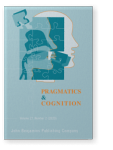Vol. 27:2 (2020) ► pp.387–407
A properly pragmatist pragmatics
Peircean reflections on the distinction between semantics and pragmatics
Although most contemporary philosophers of language hold that semantics and pragmatics require separate study, there is surprisingly little agreement on where exactly the line should be drawn between these two areas, and why. In this paper I suggest that this lack of clarity is at least partly caused by a certain historical obfuscation of the roots of the founding three-way distinction between syntax, semantics and pragmatics in Charles Peirce’s pragmatist philosophy of language. I then argue for recovering and revisiting these original roots, taking indexicality as a case-study of how certain questions connected with the distinction which are currently considered complex and difficult may be clarified by a ‘properly pragmatist pragmatics’. Such a view, I shall argue, upends a certain priority usually accorded to semantics over pragmatics, teaching that we do not work out what terms mean in some abstract overall sense and then work out to what use they are being put; rather, we must understand to what use terms are being put in order to understand what they mean.
Article outline
- 1.Introduction
- 2.What is indexicality?
- 3.‘Pre-indexical’ analytic formal semantics: The downfall of ‘pure’ semantics
- 4.‘Post-indexical’ analytic formal semantics
- 5.Indexicality in a semeiotic context
- 6.Indexical purpose
- 7.A properly pragmatist pragmatics
- Acknowledgements
- Notes
-
References
